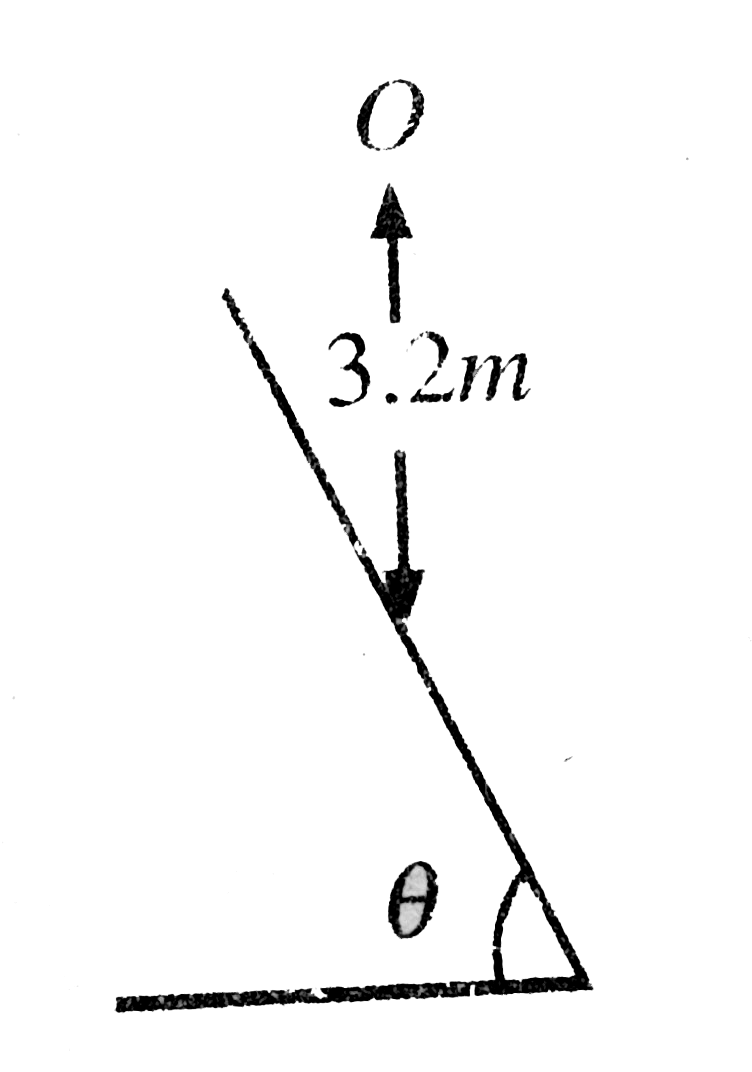A ball of mass 1 kg falls from a height of 5m above the free surface of water. The relative density of the solid ball is s=2/3. The ball travels a distance of 2m under water and becomes stationary. The work done by the resistive forces of water is
−50J
−20J
−40J
−30J
The correct Answer is:C
To find the work done by the resistive forces of water on a ball that falls into it, we can follow these steps:
Step 1: Calculate the gravitational potential energy (GPE) of the ball before it falls.
The gravitational potential energy when the ball is at a height h is given by the formula:
GPE=mgh
where:
- m=1kg (mass of the ball)
- g=10m/s2 (acceleration due to gravity)
- h=5m (height from which the ball falls)
Substituting the values:
GPE=1×10×5=50J
Step 2: Determine the buoyant force acting on the ball.
The buoyant force FB can be calculated using the formula:
FB=ρwater⋅V⋅g
where:
- ρwater=1000kg/m3 (density of water)
- V is the volume of the ball
To find the volume V, we can use the relative density s of the ball:
s=ρballρwater⇒ρball=s⋅ρwater=23⋅1000=20003kg/m3
The volume of the ball can be calculated using:
V=mρball=120003=32000m3
Now substituting V into the buoyant force formula:
FB=1000⋅32000⋅10=15N
Step 3: Calculate the work done by the buoyant force.
The work done by the buoyant force WB when the ball travels 2m under water is given by:
WB=FB⋅d
where d=2m:
WB=15⋅2=30J
Step 4: Apply the work-energy theorem.
According to the work-energy theorem:
Work done by all forces=ΔKE
Since the ball comes to rest, the change in kinetic energy ΔKE=0. Therefore, the total work done by all forces (gravitational force, buoyant force, and resistive force) is zero:
Wgravity+WB+WR=0
Step 5: Calculate the work done by the gravitational force.
The work done by gravity Wgravity when the ball falls 5m is:
Wgravity=mgh=50J
Step 6: Set up the equation to find the work done by resistive forces.
Substituting the known values into the work-energy theorem:
50+30+WR=0
WR=−80J
Conclusion
The work done by the resistive forces of water is:
WR=−80J
The gravitational potential energy when the ball is at a height h is given by the formula:
GPE=mgh
where:
- m=1kg (mass of the ball)
- g=10m/s2 (acceleration due to gravity)
- h=5m (height from which the ball falls)
GPE=1×10×5=50J
The buoyant force FB can be calculated using the formula:
FB=ρwater⋅V⋅g
where:
- ρwater=1000kg/m3 (density of water)
- V is the volume of the ball
s=ρballρwater⇒ρball=s⋅ρwater=23⋅1000=20003kg/m3
V=mρball=120003=32000m3
FB=1000⋅32000⋅10=15N
The work done by the buoyant force WB when the ball travels 2m under water is given by:
WB=FB⋅d
where d=2m:
WB=15⋅2=30J
According to the work-energy theorem:
Work done by all forces=ΔKE
Since the ball comes to rest, the change in kinetic energy ΔKE=0. Therefore, the total work done by all forces (gravitational force, buoyant force, and resistive force) is zero:
Wgravity+WB+WR=0
The work done by gravity Wgravity when the ball falls 5m is:
Wgravity=mgh=50J
Substituting the known values into the work-energy theorem:
50+30+WR=0
WR=−80J
The work done by the resistive forces of water is:
WR=−80J
Topper's Solved these Questions
- BOOK - DC PANDEY ENGLISHCHAPTER - FLUID MECHANICSEXERCISE - B) Medical entrance special format question19videos
FLUID MECHANICS
- BOOK - DC PANDEY ENGLISHCHAPTER - FLUID MECHANICSEXERCISE - Match the columns6videos
FLUID MECHANICS
- BOOK - DC PANDEY ENGLISHCHAPTER - FLUID MECHANICSEXERCISE - Check point 13.410videos
FLUID MECHANICS
- BOOK - DC PANDEY ENGLISHCHAPTER - EXPERIMENTSEXERCISE - Subjective15videos
EXPERIMENTS
- BOOK - DC PANDEY ENGLISHCHAPTER - GENERAL PHYSICSEXERCISE - INTEGER_TYPE2videos
GENERAL PHYSICS
Similar Questions
A ball of mass 1 kg falls from a height of 5 m above the free surface of water. The relative density of the solid ball is s=23. The ball travels a distance of 2 m under water and becomes stationary. The work done by the resistive forces of water is (−10n)J. Find value of n.
View SolutionA ball of mass 1kg is dropped from a height of 3.2m on smooth inclined plane. The coefficient of restitution for the collision is e=1/2. The ball's velocity become horizontal after the collision.
 View Solution
View SolutionA ball of mass 5.0 gm and relative density 0.5 strikes the surface of the water with a velocity of 20 m/sec. It comes to rest at a depth of 2m. Find the work done by the resisting force in water: (take g=10m/s2)
View SolutionA ball is dropped from a height of 20m above the surface of water in a lake. The refractive index of water is 4/3. A fish inside the lake , in the line fall of the ball, is looking at the ball. At an instant when the balll is 12.8m above the water surface, the fish sees the speed of ball as .
View SolutionA ball whose density is 0.4×103kg/m3 falls into water from a height of 9 cm. To what depth does the ball sink ?
View SolutionA ball of mass 05 kg slows down from a speed of 5 m s−1 to that of 3 m s−1 . Calculate the change in the kinetic energy of the ball.
View SolutionA ball of mass 0.2 kg moves with a velocity of 20m/sec and it stops in 0.1 sec , then the force on the ball is
View SolutionA ball of mass 0.2 kg moves with a velocity of 20m/sec and it stops in 0.1 sec , then the force on the ball is
View SolutionAn under water swimmer is at a depth of 12 m below the surface of water. A bird is at a height of 18 m from the surface of water, directly above his eyes. For the swimmer the bird appears to be at a distance from the surface of water equal to (Refractive Index of water is 4/3)
View SolutionA ball of mass 2 kg is gently pushed off the edge of a tabletop that is 1.8 m above the floor. Find the speed of the ball as it strikes the floor.
View Solution

